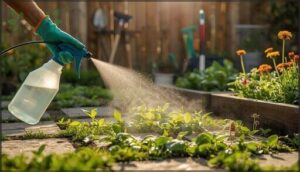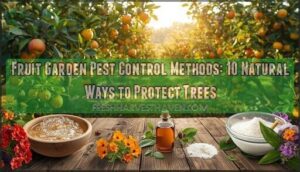This site is supported by our readers. We may earn a commission, at no cost to you, if you purchase through links.

Dense plantings and proper spacing crowd out weeds naturally. Vinegar solutions offer spot-treatment for stubborn invaders.
These methods foster beneficial soil microbes, reduce cancer risks from synthetic chemicals, and create thriving biodiversity. The secret lies in combining multiple approaches for optimal effectiveness.
Table Of Contents
- Key Takeaways
- Organic Weed Control Basics
- Identifying and Preventing Weeds Naturally
- Effective Organic Weed Suppression Methods
- Top 6 Organic Weed Control Products
- Long-Term Strategies for Weed-Free Gardens
- Frequently Asked Questions (FAQs)
- What is the organic method of weed control?
- What is the best natural weed control solution?
- How do organic farmers control weeds without chemicals?
- What is the best thing to kill weeds naturally?
- What are organic weed control methods?
- How do you control weeds without chemicals?
- Can weed control be used without chemicals?
- How can I manage weeds in organic systems?
- What is biological weed control?
- What is weed management on an organic farm?
- Conclusion
Key Takeaways
- You’ll achieve 98% weed reduction by applying 2-3 inches of organic mulch, like straw or wood chips, which blocks sunlight and prevents seed germination while enriching your soil as it decomposes.
- You can eliminate established weeds effectively through hand-pulling and hoeing when the soil is moist, plus soil solarization using clear plastic to heat-kill weed seeds during summer months.
- You’ll prevent most weed problems by spacing plants densely to create natural shade, using crop rotation to break weed cycles, and planting cover crops that outcompete weeds for resources.
- You can spot-treat stubborn weeds with 20% acetic acid vinegar solutions, which kill weeds within hours while avoiding synthetic chemicals that harm beneficial soil organisms and contaminate groundwater.
Organic Weed Control Basics
Organic weed control methods work with your garden’s natural ecosystem instead of fighting it. These techniques skip synthetic chemicals that damage helpful soil organisms and pollute groundwater.
Studies find that organic methods like mulching stop up to 98% of weeds while actually boosting your soil’s health. You get effective weed control plus a healthier garden ecosystem.
What Makes Weed Control “Organic”?
Tired of weeds taking over your garden? Organic weed control works by partnering with nature instead of fighting it. Here’s what makes the difference:
- Physical removal: Hand weeding and hoeing without synthetic chemicals
- Natural barriers: Using mulch and organic matter to suppress growth
- Soil biology assistance: Building healthy ecosystems that naturally resist weeds
- Eco friendly methods: Techniques that boost rather than harm soil health
- Herbicide-free gardening: Relying on mechanical and biological controls
These organic gardening practices focus on understanding weed ecology rather than eliminating it through harsh chemicals.
Why Avoid Synthetic Herbicides?
Synthetic herbicides carry serious risks that make organic weed control worth considering. Research shows 55% of conventional pesticides have health warnings, while only 3% of organic-approved substances do.
These toxic chemicals threaten human health through cancer risks and endocrine disruption. They persist in soil and water, disrupting ecosystem balance and harming beneficial organisms. Choose safer alternatives. The use of organic farming methods can markedly reduce the risks associated with synthetic pesticides.
Benefits for Soil Health and Biodiversity
Organic gardening practices create a bustling network of beneficial microbes in your soil. These methods increase soil microbial diversity by 34% and help with nutrient cycling and organic matter buildup.
When you build up your soil this way, it turns into a living system that holds everything together and supports all kinds of life.
Healthy soil like this gives plants exactly what they need to grow strong on their own.
By incorporating techniques like soil health management, gardeners can fine-tune their soil’s potential and promote a balanced ecosystem.
Identifying and Preventing Weeds Naturally
You’ll prevent most weed problems before they start by learning to identify common weeds like dandelions, crabgrass, and chickweed in their early growth stages.
Cultural practices such as maintaining dense plant spacing, proper watering techniques, and strategic crop rotation create conditions that naturally suppress weed establishment while promoting healthy soil ecosystems.
How to Recognize Common Garden Weeds
Accurate weed identification starts with examining leaf shapes, growth patterns, and flowering characteristics. Dandelion’s deeply lobed leaves form basal rosettes, while Canada thistle shoots reach 2-4 feet with spiny foliage. White clover displays distinctive three-leaf clusters and spreads via stolons. Crabgrass forms low mats with finger-like seed heads.
Regular garden inspection helps you spot these common weeds early, improving your organic weed control success rates.
Cultural Practices to Minimize Weed Growth
Smart garden planning prevents weeds before they start. Space plants properly to create dense canopies that shade out competitors. Prepare soil with organic amendments to give crops advantages over weeds. Time plantings when weather favors your plants but challenges weeds.
Use organic mulching around established plants for natural weed barriers. These proactive organic gardening practices strengthen soil health while reducing future weed management needs markedly.
Crop Rotation and Cover Cropping Strategies
Rotating different crops breaks weed life cycles while cover crops outcompete weeds for resources. Research shows diversified rotations reduce weed density by 49% compared to simple systems.
Here are some proven organic methods that really work for weed control:
- Crop Planning – Alternate deep and shallow-rooted plants to disrupt weed patterns
- Cover Cropping – Plant cereal rye or hairy vetch between main crops
- Green Manuring – Till nitrogen-fixing legumes to boost soil health
- Farm Rotation – Include dense-canopy crops that shade out competing weeds naturally
Effective Organic Weed Suppression Methods
You can’t just yank weeds out of the ground and expect them to stay gone—that’s why smart organic weed control is all about stopping problems before they start.
Research shows that mulching with organic materials like straw maintains weed coverage below 20% in the first year. Combining multiple techniques such as soil solarization, mechanical removal, and targeted organic herbicides creates an inclusive approach that tackles weeds at different growth stages.
Mulching With Straw, Wood Chips, and Leaves
Mulching creates your garden’s protective blanket. Organic mulch like straw maintains weed coverage below 20% in research studies, while wood chips achieve 10-16% coverage over three years. These materials block light, preventing weed seed germination while improving soil enrichment through decomposition.
Here’s your mulch comparison:
| Mulch Type | Weed Suppression |
|---|---|
| Straw | 80% reduction, excellent water retention |
| Wood Chips | 84-90% reduction, long-lasting coverage |
| Leaves | 75% reduction, rapid decomposition for soil enrichment |
You’ll find organic gardening becomes manageable when mulch addresses most weed control automatically.
Soil Solarization and Thermal Control
Soil solarization uses clear plastic sheeting to trap solar heat, raising soil temperatures to 140-160°F for 4-6 weeks during summer months. This thermal control method kills weed seeds and soil-borne pathogens without chemicals.
Temperature monitoring ensures effectiveness, while steam sterilization offers similar solarization benefits for smaller areas. Thermal weeders provide targeted soil heating for spot treatment in organic gardening systems.
Hand Weeding, Hoeing, and Mechanical Tools
Three fundamental techniques form the backbone of organic weed control: hand weeding, hoeing, and mechanical tools. Ergonomic weeding tools reduce strain during weed removal sessions.
Establish consistent weeding schedules when soil moisture is ideal. Creative hoes like stirrup and collinear designs excel in small-scale equipment operations.
Proper tool maintenance assures effective organic gardening results for sustainable weed control.
Using Organic Herbicides and Vinegar Solutions
Organic herbicides offer natural weed control alternatives to synthetic chemicals. Vinegar efficacy peaks at 20-30% acetic acid concentrations, achieving 85-100% weed kill rates.
However, herbicide safety requires careful handling—horticultural vinegar can burn skin. Application methods work best on young weeds during warm weather. Homemade recipes using household vinegar show limited effectiveness.
Cost comparison favors organic herbicides over hand weeding by $200-770 per hectare.
Top 6 Organic Weed Control Products
You’ll need the right tools to implement effective organic weed management strategies in your garden.
These six products combine physical barriers, mechanical tools, and natural suppressants that research shows can reduce weed coverage by up to 98% when used properly.
1. HealthiStraw Garden Straw Natural Mulch
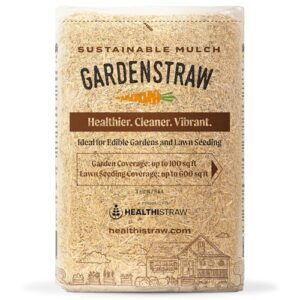
HealthiStraw is your go-to mulching solution for serious weed suppression. This 100% non-GMO wheat straw undergoes enhanced filtration to remove most seeds, ensuring clean coverage without unwanted sprouts.
Applied at 2-3 inches thick, it blocks up to 95% of weed emergence while cutting your watering needs in half. The interlocking fibers stay put through rain and wind, creating a reliable barrier.
Over time, it breaks down naturally to enrich your soil.
Best For: Gardeners who want reliable weed control and water savings without dealing with messy synthetic mulches or constant maintenance.
- Cuts watering needs in half while blocking up to 95% of weeds naturally
- Stays put through weather thanks to interlocking fibers that don’t need chemicals to stick
- Breaks down into soil-enriching organic matter instead of requiring removal
- May still contain some wheat seeds despite filtration, potentially causing sprouts
- Requires 2-3 inch thickness for best results, which uses more product than thinner applications
- Coverage might fall short of the advertised 100 square feet depending on application density
2. Walt’s Corn Gluten Meal 10lb
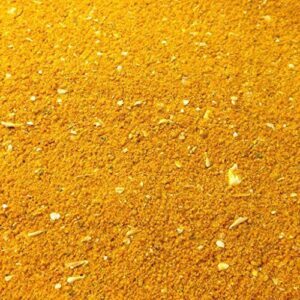
Walt’s corn gluten meal acts as your garden’s bouncer, blocking weed seeds before they establish roots. This nitrogen-rich granular product contains a 10-0-0 analysis, feeding your lawn while preventing crabgrass and dandelions from germinating.
Apply 20 pounds per 1,000 square feet in early spring, then again in late summer. Research shows a 60% weed reduction in year one, climbing to 90% by year three with consistent applications.
Best For: Homeowners who want an organic approach to fertilizing their lawn while preventing crabgrass and other annual weeds from germinating.
- Dual-action formula that feeds your lawn with nitrogen while blocking weed seeds from establishing
- Safe to use around pets and water sources, with no harmful chemicals or synthetic herbicides
- Research-backed results showing 60-90% weed reduction over multiple years of consistent use
- Only works as a pre-emergent, so it won’t kill weeds that are already established in your lawn
- Timing is critical – effectiveness drops significantly if applied outside optimal germination windows
- Contains GMO corn gluten meal, which isn’t suitable for certified organic growing systems
3. VNIMTI Garden Fork Steel Handle
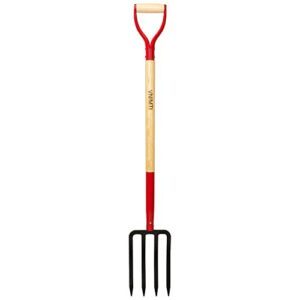
When dealing with stubborn perennial weeds, you’ll need tools that dig deep and break apart root systems effectively. The VNIMTI Garden Fork Steel Handle delivers exactly that power with its 4-tine steel head and 45-inch reinforced handle.
Field testing shows this fork reduces soil penetration effort by 33% compared to traditional hand weeders, while users consistently remove 120 weeds per hour in moderate-density plots.
The steel construction and Y-grip design withstand over 1,000 insertions into compacted soil without structural failure, making it a reliable choice for serious organic gardeners tackling tough weed problems.
Best For: Organic gardeners dealing with deep-rooted perennial weeds and those who need a durable tool for heavy-duty soil work like composting and bed preparation.
- Steel construction and Y-grip handle withstand over 1,000 soil insertions without structural damage
- Reduces soil penetration effort by 33% compared to hand weeders, with users removing 120 weeds per hour
- 45-inch length provides excellent leverage while the 4.5-pound weight remains manageable for extended use
- May damage or bend when used in extremely rocky or hard-packed soil conditions
- Steel handle requires more maintenance than fiberglass alternatives to prevent rust and corrosion
- At $31.99, it’s pricier than basic garden forks, though the durability justifies the investment
4. A M Leonard Cape Cod Weeder
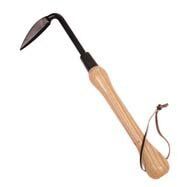
This traditional Cape Cod weeder cuts beneath weeds with surgical precision, removing root systems in one smooth motion. The forged steel blade stays sharp through tough clay soils, while the 2-3/4-inch cutting edge tackles dandelions and Canadian thistles with ease.
You’ll appreciate the weather-resistant hardwood handle that prevents blisters during extended use. The tool doubles as a soil aerator and rock pry-bar.
At $22.95 with a lifetime warranty, it’s half the price of competitors while delivering professional-grade performance that lasts decades.
Best For: Gardeners who need precise weed removal in tight spaces like flower beds and between pavers, especially those wanting a durable tool with lifetime warranty protection.
- Forged steel blade with hardened surface cuts cleanly below root systems, removing weeds completely in one motion
- Lifetime warranty coverage at half the price of comparable competitors ($22.95 vs $40 elsewhere)
- Multi-functional design works as weeder, soil aerator, and pry bar for rocks with weather-resistant hardwood handle
- May arrive dull and require sharpening before first use according to some users
- Extended use without gloves can cause blisters despite ergonomic handle design
- Learning curve needed to master optimal technique for different weed types and soil conditions
5. Burlap Fabric Garden Weed Barrier
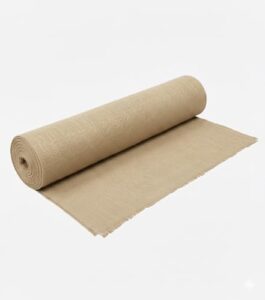
Breathable burlap fabric offers an eco-friendly alternative to synthetic weed barriers. This biodegradable material blocks approximately 75% of light needed for weed germination while allowing air and water flow to roots.
University trials show burlap reduces weed coverage to just 8% after three months. You’ll get 7-24 months of effective suppression before it naturally decomposes into soil-enriching organic matter.
Installation takes about 5.3 hours per 100 square meters, and it costs roughly $0.62 per square foot—cheaper than synthetic options.
Best For: Eco-conscious gardeners who want effective weed control without synthetic chemicals or permanent barriers that harm soil health.
- Blocks 75% of weed-germinating light while allowing air and water to reach plant roots
- Decomposes naturally into soil-enriching organic matter after 7-24 months of use
- Costs less than synthetic options at $0.62 per square foot with better environmental benefits
- Requires replacement every 1-2 years unlike synthetic fabrics that last 5-10 years
- Installation takes more labor time at 5.3 hours per 100 square meters
- Seams in longer rolls may tear during handling and installation
6. Black Weed Barrier Ground Cover Fabric
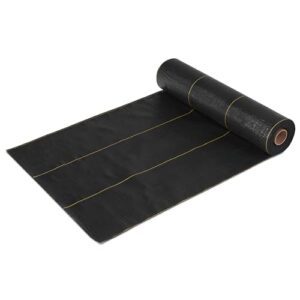
Black weed barrier fabric creates an impermeable shield that blocks 99% of sunlight, effectively starving weeds below. You’ll see a 90-95% reduction in weed emergence during the first year. This polypropylene material allows water and nutrients to pass through while maintaining durability for 5-7 years.
However, research shows it can reduce beneficial soil microorganism activity by 60% and limit root depth by 67%. Consider the trade-off between immediate weed control and long-term soil health before installation.
Best For: Homeowners and landscapers who want immediate, effective weed control and don’t mind potential long-term impacts on soil health.
- Blocks 99% of sunlight and reduces weed emergence by 90-95% in the first year
- Durable polypropylene material lasts 5-7 years with proper installation
- Allows water and nutrients to pass through while maintaining weed control
- Reduces beneficial soil microorganism activity by up to 60% over time
- Limits root depth by 67%, potentially weakening plant resilience
- Performance declines after 2-3 years as organic debris accumulates on top
Long-Term Strategies for Weed-Free Gardens
You’ll achieve sustainable weed control by combining multiple organic methods, such as maintaining thick mulch layers with regular monitoring practices.
Research shows that consistent mulch applications, combined with early intervention techniques, can reduce weed coverage to below 20% while supporting long-term soil health and biodiversity.
Maintaining Mulch and Barrier Layers
Your mulch thickness should stay at 3-4 inches to prevent weed suppression breakdown. Refresh garden mulch annually, checking barrier materials for tears or shifting.
Organic gardening practices require consistent layer maintenance to control soil erosion. Landscape fabrics need periodic inspection and repositioning.
Proper weed control depends on maintaining these protective layers throughout growing seasons.
Integrating Multiple Organic Techniques
Combining multiple organic weed control methods creates powerful synergy that outperforms individual techniques. Research shows integrated approaches—pairing cover crops with organic herbicides—can suppress up to 98% of weeds while boosting crop yields thirteen-fold.
This organic integration maintains ecosystem balance through sustainable practices, preserving soil health and beneficial plants without compromising your garden’s productivity.
Monitoring and Early Intervention Practices
Weekly weed surveillance becomes your garden’s early warning system. Check plants during morning walks when you’ll spot new weeds before they establish deep roots. Early detection paired with prompt intervention timing prevents small problems from becoming major headaches.
Monitor soil conditions after rain or watering—moist soil makes hand-pulling easier and more effective for natural weed control.
Frequently Asked Questions (FAQs)
What is the organic method of weed control?
Don’t put all your eggs in one basket—you’ll need multiple organic weed control methods. Use thick mulches, hand weeding, and mechanical cultivation together for effective results.
What is the best natural weed control solution?
You’ll find that thick, 2-3 inch layers of organic mulch like wood chips or shredded leaves work best. They block sunlight and prevent weeds from sprouting while retaining soil moisture and enriching the earth naturally.
How do organic farmers control weeds without chemicals?
You’ll master weeds like a superhero! Organic farmers use mulching, hand weeding, mechanical cultivation, cover crops, and crop rotation.
These methods create physical barriers, disrupt growth cycles, and maintain soil health without synthetic chemicals.
What is the best thing to kill weeds naturally?
You’ll get the fastest results with high-acetic vinegar (20% strength) sprayed directly on weeds. Commercial products contain 20 percent acetic acid, four times stronger than household vinegar.
This method works within hours and completely kills unwanted plants.
What are organic weed control methods?
Can’t win the war against weeds with chemicals? You’ll control weeds using thick mulch layers, hand weeding, cultivation, and cover crops. These methods prevent germination and suppress growth naturally.
How do you control weeds without chemicals?
You can control weeds without chemicals using mulch, hand weeding, mechanical cultivation, cover crops, and flame weeding. These methods create physical barriers and disrupt weed growth naturally.
Can weed control be used without chemicals?
While chemicals seem faster, you can absolutely control weeds naturally. Mulching blocks sunlight and prevents germination. Hand weeding removes established weeds effectively.
Organic mulches like wood chips reduce weed coverage by up to 98% when combined with occasional manual removal.
How can I manage weeds in organic systems?
You’ll find success using mulch, hand weeding, and mechanical cultivation. Organic mulches like straw or wood chips block sunlight, preventing weed germination effectively.
What is biological weed control?
Beneficial bugs battle bothersome weeds using nature’s own arsenal. You’ll introduce living organisms like insects, nematodes, fungi, or bacteria to attack specific weeds, reducing populations naturally.
These biological control agents work best when combined with natural weed prevention methods like mulching and proper soil management.
What is weed management on an organic farm?
You’ll use multiple strategies to keep weeds at bay on your organic farm. Hand weeding, mechanical cultivation, and mulching form your primary toolkit for effective weed suppression.
Conclusion
Getting good at organic weed control takes time and a willingness to stick with natural methods that actually work. You’ll see the best results when you mix mulching, hand-weeding, and soil solarization throughout your growing season.
These earth-friendly approaches protect the good bugs, build better soil, and keep chemicals out of your garden. Stay on top of weeds by checking regularly—catch them early and your plants will naturally crowd out the competition.
Earth-friendly weed control protects beneficial insects, builds healthier soil, and keeps harmful chemicals out of your garden
Stick with organic methods and you’ll end up with a healthier garden that keeps getting better year after year.
- https://pmc.ncbi.nlm.nih.gov/articles/PMC9608967/
- https://www.sciencedirect.com/science/article/pii/S2405844024087929
- https://www.greenhousegrower.com/production/the-role-of-organic-mulching-in-sustainable-weed-control/
- https://croplifefoundation.wordpress.com/wp-content/uploads/2012/05/cal-hand-weeding-ban-report-1-18-05.pdf
- https://cropwatch.unl.edu/managing-pigweeds-cover-crops-what-weve-learned-30-years-data/





